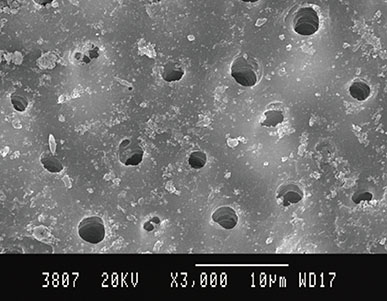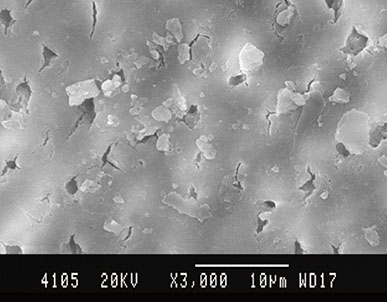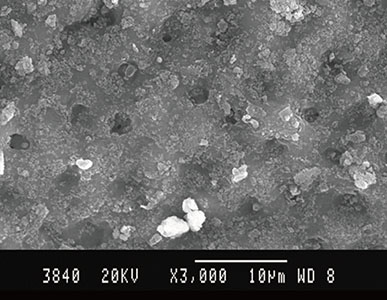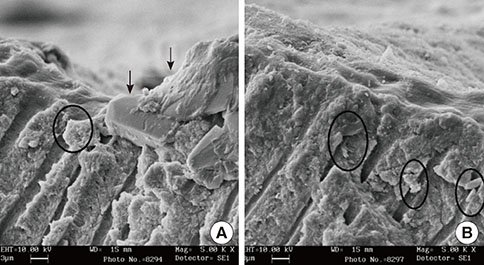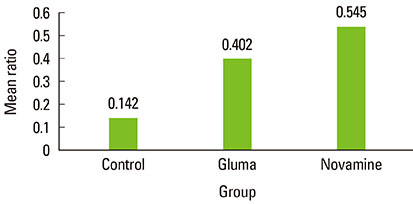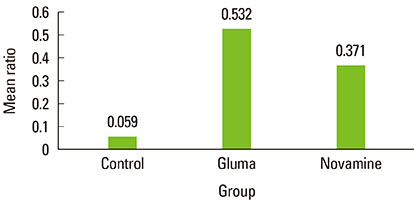J Periodontal Implant Sci.
2013 Dec;43(6):269-275.
Comparative evaluation of NovaMin desensitizer and Gluma desensitizer on dentinal tubule occlusion: a scanning electron microscopic study
- Affiliations
-
- 1Department of Periodontics, Karnavati School of Dentistry, Gandhinagar, India.
- 2Department of Periodontics, M.S. Ramaiah Dental College, Bangalore, India.
- 3Department of Conservative and Endodontics, Karnavati School of Dentistry, Gandhinagar, India. drchintanjoshi@rediffmail.com
Abstract
- PURPOSE
In this study, the effect of calcium sodium phosphosilicate (NovaMin) desensitizing agent, which is a powder-based system, and hydroxyethyl methacrylate and glutaraldehyde (Gluma desensitizer), which is liquid-based system, on dentinal tubule occlusion was analyzed by scanning electron microscope. The effects of the above two along with one control group were compared to determine the more effective method of sealing the dentinal tubules after initial application.
METHODS
Twenty specimens were allocated to each of 3 groups: Control, Gluma desensitizer, and NovaMin. Two additional samples were also prepared and treated with Gluma and NovaMin; these samples were longitudinally fractured. The specimens were prepared from extracted sound human premolars and were stored in 10% formalin at room temperature. The teeth were cleaned of gross debris and then sectioned to provide one to two dentin specimens. The dentin specimens were etched with 6% citric acid for 2 minutes and rinsed in distilled water. Control discs were dried, and the test discs were treated with the desensitizing agents as per the manufacturer's instructions. The discs as well as longitudinal sections were later analyzed under the scanning electron microscope. The proportions of completely occluded, partially occluded, and open tubules within each group were calculated. The ratios of completely and partially occluded tubules to the total tubules for all the groups was determined, and the data was statistically analyzed using nonparametric tests and statistical significance was calculated.
RESULTS
NovaMin showed more completely occluded tubules (0.545+/-0.051) while Gluma desensitizer showed more partially occluded tubules (0.532+/-0.075). The differences among all the groups were statistically significant (P< or = 0.05).
CONCLUSION
Both materials were effective in occluding dentinal tubules but NovaMin appeared more promising in occluding tubules completely after initial application.
MeSH Terms
Figure
Reference
-
1. Banoczy J. Dentine hypersensitivity: general practice considerations for successful management. Int Dent J. 2002; 52:Suppl 5. 366.2. Johnson RH, Zulqar-Nain BJ, Koval JJ. The effectiveness of an electro-ionizing toothbrush in the control of dentinal hypersensitivity. J Periodontol. 1982; 53:353–359.
Article3. Curro FA. Tooth hypersensitivity in the spectrum of pain. Dent Clin North Am. 1990; 34:429–437.4. Bamise CT, Olusile AO, Oginni AO. An analysis of the etiological and predisposing factors related to dentin hypersensitivity. J Contemp Dent Pract. 2008; 9:52–59.
Article5. Dababneh RH, Khouri AT, Addy M. Dentine hypersensitivity - an enigma? A review of terminology, mechanisms, aetiology and management. Br Dent J. 1999; 187:606–611.
Article6. Narhi MV. Responses of pulpal nociceptors to tissue injury and inflammation. In : Addy M, Embery G, Edgar WM, Orchardson R, editors. Tooth wear and sensitivity: clinical advances in restorative dentistry. London: Martin Dunitz;2000. p. 257–266.7. Jacobsen PL, Bruce G. Clinical dentin hypersensitivity: understanding the causes and prescribing a treatment. J Contemp Dent Pract. 2001; 2:1–12.
Article8. Orchardson R. Strategies for the management of dentine hypersensitivity. In : Addy M, Embery G, Edgar WM, Orchardson R, editors. Tooth wear and sensitivity: clinical advances in restorative dentistry. London: Martin Dunitz;2000. p. 315–325.9. Litkowski L. Pilot clinical and in vitro studies evaluating NovaMin in desensitizing dentifrices [abstract]. Dent Res. 1998; 77:199.10. Absi EG, Addy M, Adams D. Dentine hypersensitivity: a study of the patency of dentinal tubules in sensitive and non-sensitive cervical dentine. J Clin Periodontol. 1987; 14:280–284.
Article11. Yoshiyama M, Masada J, Uchida A, Ishida H. Scanning electron microscopic characterization of sensitive vs. insensitive human radicular dentin. J Dent Res. 1989; 68:1498–1502.
Article12. Pashley DH, Carvalho RM. Dentine permeability and dentine adhesion. J Dent. 1997; 25:355–372.
Article13. West NX. Dentine hypersensitivity: preventive and therapeutic approaches to treatment. Periodontol 2000. 2008; 48:31–41.14. Ling TY, Gillam DG, Barber PM, Mordan NJ, Critchell J. An investigation of potential desensitizing agents in the dentine disc model: a scanning electron microscopy study. J Oral Rehabil. 1997; 24:191–203.
Article15. Morris MF, Davis RD, Richardson BW. Clinical efficacy of two dentin desensitizing agents. Am J Dent. 1999; 12:72–76.16. Gillam DG, Mordan NJ, Sinodinou AD, Tang JY, Knowles JC, Gibson IR. The effects of oxalate-containing products on the exposed dentine surface: an SEM investigation. J Oral Rehabil. 2001; 28:1037–1044.
Article17. Arrais CA, Chan DC, Giannini M. Effects of desensitizing agents on dentinal tubule occlusion. J Appl Oral Sci. 2004; 12:144–148.
Article18. LJ Litkowski GD Hack DC Greenspan . US Biomaterials Co.Compositions containing bioactive glass and their use in treating tooth hypersensitivity. United States patent. US 5,735,942. 1998. Apr. 07.19. LJ Litkowski GD Hack DC Greenspan . US Biomaterials Co.Methods of treatment using bio-active glass. United States patent. US 6,086,374. 2000. Jul. 11.20. Wefel JS. NovaMin: likely clinical success. Adv Dent Res. 2009; 21:40–43.
Article21. Rajesh KS, Hedge S, Arun Kumar MS, Shetty DG. Evaluation of the efficacy of a 5% calcium sodium phosphosilicate (Novamin) containing dentifrice for the relief of dentinal hypersensitivity: a clinical study. Indian J Dent Res. 2012; 23:363–367.
Article22. Kolker JL, Vargas MA, Armstrong SR, Dawson DV. Effect of desensitizing agents on dentin permeability and dentin tubule occlusion. J Adhes Dent. 2002; 4:211–221.23. Schüpbach P, Lutz F, Finger WJ. Closing of dentinal tubules by Gluma desensitizer. Eur J Oral Sci. 1997; 105(5 Pt 1):414–421.
Article24. In-Vitro evaluation of NovaMin root conditioner. Internal Research Report [Internet]. Alachua (FL): NovaMin Technology Inc.;cited 2013 Mar 15. Available from: http://www.oralscience.ca/en/documentation/articles/tooth_paste/In-Vitro-Evaluation-of-NovaMin-Root-Conditioner.pdf.25. Du Min Q, Bian Z, Jiang H, Greenspan DC, Burwell AK, Zhong J, et al. Clinical evaluation of a dentifrice containing calcium sodium phosphosilicate (novamin) for the treatment of dentin hypersensitivity. Am J Dent. 2008; 21:210–214.26. de Assis Cde A, Antoniazzi RP, Zanatta FB, Rosing CK. Efficacy of Gluma Desensitizer on dentin hypersensitivity in periodontally treated patients. Braz Oral Res. 2006; 20:252–256.
Article
- Full Text Links
- Actions
-
Cited
- CITED
-
- Close
- Share
- Similar articles
-
- A SEM study of dentinal tubule sealing effect of desensitizing agent applicated after root planning
- The effects of desensitizing agents, bonding resin and tooth brushing on dentin permeability, in vitro
- Effect of GLUMA desensitizer on the retention of full metal crowns cemented with Rely X U200 self-adhesive cement
- The Effect Of Temporary Cement And Desensitizer On The Bond Strength Of Luting Cements
- Effect Of Dentin Desensitizers On Shear Bond Strength Of Resin Cements

